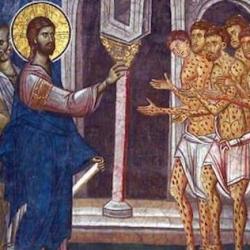In his contribution to Purity and the Forming of Religious Traditions, Philippe Borgeaud explores ancient comparative anthropology, the ways in which Greeks used other cultures as “mirrors.”
Along the way (269-70), he discusses Porphyry’s De Abstinentia, which he compares to Mary Douglas’s classic Purity and Danger. For Porphyry, “purity is defined as an ‘absence of mixture,’ amixia, whereas pollution is the result of such a mixture. It is in order to avoiding getting mixed with that one has to beware of consuming certain types of food.”
What shouldn’t be mixed with what? Porphyry answers one ought “not to mix the same (i.e., oneself) with the other, or more precisely, with the opposite; not to mix my living body with certain foods, and especially animal flesh. Inasmuch as it implies the dead body of the animal, such diet would amount to mixing up the eating, living being with the dead being that is being eaten. Or, to put it differently, one should not mix up the same with the allegorical principle that is hidden in the other, the rejected food.” The same principle applies to certain kinds of vegetable food as well.
The principle is that “purity consists of abstaining from mixing oneself with one’s opposite. The agneia amounts to rejection (apothesis) and abstinence (aphexis) from the multiple as well as from all opposites (ton pollon kai enantion). It means the isolation (monosis) and the seizure (lepsis) of what is familiar and natural conforms (ton oikeion kai prosphuon).”
From food, Porphyry turns to sexual purity, and condemns both “hetero- and homosexual unions, as well as nightly pollutions, inasmuch as the latter imply, from a masculine perspective, the ‘feminization’ of the soul and thus a mixture of masculine and feminine (in addition to a mixture of life/death, because of what is done with the sperm, which gets lost and dies in the process).”
From food to sex to society: “This concern with maintaining the integrity of the same and protecting it from any interaction with something contrary or contradictory accounts for the fact that . . . Porphyry, describing Spartan life as it was regulated by Lycurgus . . . , praises certain measures, the effect of which is to avoid contacts between foreigners (such as itinerant merchants, or other categories) and the populations. Fear of the contrary leads to fear of the other.”
Like the Hebrews, in other words, some Greeks used food prohibitions as markers of social division. Purity of diet was an effective sign of avoidance of social mixtures.
But we can also see here the link between purity and death. After all, if one avoids all mixture of oneself and another, one will be condemned to a short and hungry life (masters of inedia excepted perhaps). Death has to mix with life if life is going to go on, and insofar as purity regulations rule out mixtures of death with life, they are promoting death.
We might say the same about the social dimensions of purity: The human race is a dead body so long as members refuse to mix with one another. Mixture is necessary for social vibrancy; mixture prevents stagnation in culture, technology, genetics, what have you.
Perhaps we shouldn’t merely say that the body of Christ is a new sort of social body. Perhaps we should add that the body of Christ, precisely as the mixed body where purity barriers have been demolished, is the first living social body since Adam.















